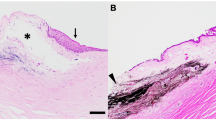Abstract
A novel method of in vivo targeted gene transfer to intentionally selected areas of the corneal endothelium was developed. Plasmid DNA with the lacZ gene coding for β-galactosidase was injected into the anterior chamber of adult Wistar rats, and eight pulses of electricity at intensities ranging from 5 to 40 V/cm were delivered for 50 ms to the cornea with a specially designed electric probe in order to determine the effect of gene transfer on the corneal endothelial cells. Gene expression was visualized by enzymatic color reaction using X-gal in enucleated eyes on days 1, 3, 7, 14 and 21 after gene transfer. The treated eyes were then photographed and the X-gal-positive areas were evaluated by an image analyzer. The ratios of the areas (X-gal-positive area/area of entire corneal endothelium × 100%) were then calculated to determine gene transfection efficiency. The expression of β-galactosidase was clearly detected in the cytoplasm of the corneal endo- thelial cells as early as day 1 and lasted until day 21. The most intense gene expression was observed on days 1 and 3 (5.21% on day 1 and 6.45% on day 3). The expression of β-galactosidase on day 3 was most evident following delivery of 20 V electric pulses (0.09% at 5 V, 0.03% at 10 V, 6.45% at 20 V). β-Galactosidase expression was limited to the corneal endothelial cells in highly selected areas and no β-galactosidase expression was detected in any other intra- or extraocular tissues. In addition, no cell damage was apparent in the cornea and no inflammation was detected in any other intraocular tissues. Thus, low-voltage electric pulses successfully transferred the gene of interest to highly selective areas of the corneal endothelium without inducing any pathological changes. This targeted gene transfer method appears to have great potential for use in gene therapy for ocular diseases.
This is a preview of subscription content, access via your institution
Access options
Subscribe to this journal
Receive 12 print issues and online access
$259.00 per year
only $21.58 per issue
Buy this article
- Purchase on Springer Link
- Instant access to full article PDF
Prices may be subject to local taxes which are calculated during checkout
Similar content being viewed by others
Author information
Authors and Affiliations
Rights and permissions
About this article
Cite this article
Oshima, Y., Sakamoto, T., Yamanaka, I. et al. Targeted gene transfer to corneal endothelium in vivo by electric pulse. Gene Ther 5, 1347–1354 (1998). https://doi.org/10.1038/sj.gt.3300725
Received:
Accepted:
Published:
Issue Date:
DOI: https://doi.org/10.1038/sj.gt.3300725
Keywords
This article is cited by
-
A stochastic model of corneal epithelium maintenance and recovery following perturbation
Journal of Mathematical Biology (2019)
-
Transthoracic direct current shock facilitates intramyocardial transfection of naked plasmid DNA infused via coronary vessels in canines
Gene Therapy (2006)
-
Effect of GDNF gene transfer into axotomized retinal ganglion cells using in vivo electroporation with a contact lens-type electrode
Gene Therapy (2005)
-
Nonviral ocular gene transfer
Gene Therapy (2005)
-
Electroporation as a method for high-level nonviral gene transfer to the lung
Gene Therapy (2003)



